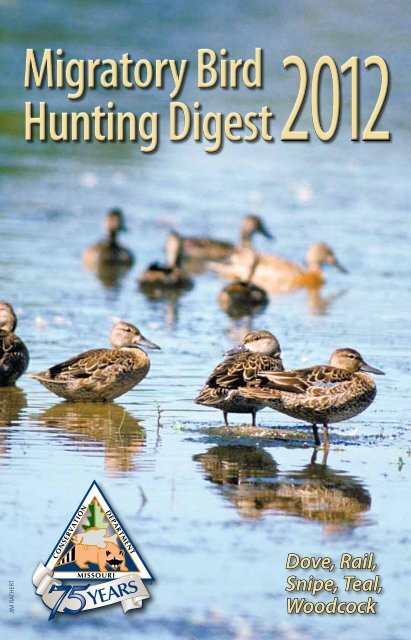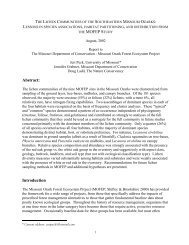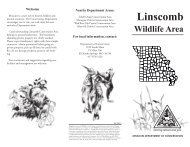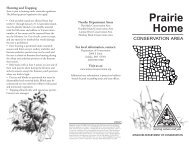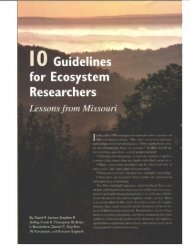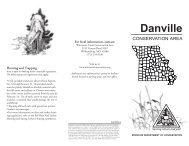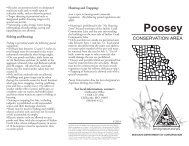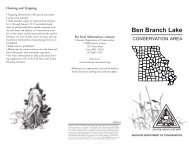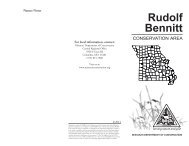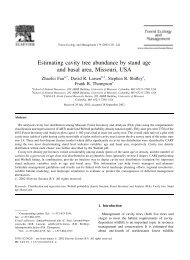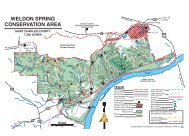Migratory Bird Hunting Digest - Missouri Department of Conservation
Migratory Bird Hunting Digest - Missouri Department of Conservation
Migratory Bird Hunting Digest - Missouri Department of Conservation
Create successful ePaper yourself
Turn your PDF publications into a flip-book with our unique Google optimized e-Paper software.
<strong>Hunting</strong> <strong>Digest</strong><br />
2012<br />
JIM RATHERT<br />
Dove, Rail,<br />
Snipe, Teal,<br />
Woodcock
Table <strong>of</strong> Contents<br />
Permit and Stamp Requirements. . . . . . . . . . . . . . . . . . . . . . . . . . . . . . . . . . . . . 2<br />
Teal Status . . . . . . . . . . . . . . . . . . . . . . . . . . . . . . . . . . . . . . . . . . . . . . . . . . . . . . . . . . 5<br />
Duck Identification . . . . . . . . . . . . . . . . . . . . . . . . . . . . . . . . . . . . . . . . . . . . . . . . . . 6<br />
Dove <strong>Hunting</strong> . . . . . . . . . . . . . . . . . . . . . . . . . . . . . . . . . . . . . . . . . . . . . . . . . . . . . . . 8<br />
Know Your Doves. . . . . . . . . . . . . . . . . . . . . . . . . . . . . . . . . . . . . . . . . . . . . . . . . . . . 9<br />
Reporting Bands and Collecting Wings. . . . . . . . . . . . . . . . . . . . . . . . . . . . . . 10<br />
Rail, Snipe and Woodcock Identification Tips . . . . . . . . . . . . . . . . . . . . . . . . 12<br />
Federal Regulations Summary . . . . . . . . . . . . . . . . . . . . . . . . . . . . . . . . . . . . . . 14<br />
Nontoxic-Shot Requirement . . . . . . . . . . . . . . . . . . . . . . . . . . . . . . . . . . . . . . . . 16<br />
<strong>Conservation</strong> Areas that Require Nontoxic Shot Only . . . . . . . . . . . . . . . . 17<br />
Regional Offices . . . . . . . . . . . . . . . . . . . . . . . . . . . . . . . . . . . . . . . . . . . . . . . . . . . . 18<br />
Sunrise/Sunset Table . . . . . . . . . . . . . . . . . . . . . . . . . . . . . . . . . . . . . . . . . . . . . . . 19<br />
2012 Season Dates . . . . . . . . . . . . . . . . . . . . . . . . . . . . . . . . . . . . . . . . . . . . . . . . . 20<br />
Harvest Survey . . . . . . . . . . . . . . . . . . . . . . . . . . . . . . . . . . . . . . . . . . . . . . . . . . . . . 20<br />
Permit and Stamp Requirements<br />
To pursue, take, possess and transport doves, rails, snipe, teal and woodcock<br />
in <strong>Missouri</strong>, a hunter must possess and carry the following, unless exempt:<br />
1) A <strong>Missouri</strong> permit 1 to hunt small game is required <strong>of</strong>:<br />
◾ <strong>Missouri</strong> residents age 16 through 64<br />
◾ Nonresidents age 16 and older<br />
An annual permit is available to residents for $10 and nonresidents for<br />
$80 from any permit vendor. A daily permit is also available to nonresidents<br />
from any permit vendor for $11 per day.<br />
Exemption: <strong>Missouri</strong> resident landowners hunting on their own land do<br />
not need a <strong>Missouri</strong> small game hunting permit, but the <strong>Migratory</strong> <strong>Bird</strong><br />
<strong>Hunting</strong> Permit is required (see below).<br />
2) <strong>Missouri</strong> <strong>Migratory</strong> <strong>Bird</strong> <strong>Hunting</strong> Permit 1 is required <strong>of</strong>:<br />
◾ Residents and nonresidents age 16 and over<br />
This permit is available for $6 from any permit vendor. Purchase <strong>of</strong><br />
this permit satisfies requirements for <strong>Migratory</strong> Game <strong>Bird</strong> Harvest<br />
Registration.<br />
3) Federal <strong>Migratory</strong> <strong>Bird</strong> <strong>Hunting</strong> and <strong>Conservation</strong> Stamp is required <strong>of</strong>:<br />
◾ Every teal hunter age 16 and over (Dove, rail, snipe and woodcock<br />
hunters do not need this stamp.)<br />
To be valid, the Federal <strong>Migratory</strong> <strong>Bird</strong> <strong>Hunting</strong> and <strong>Conservation</strong> Stamp<br />
(duck stamp) must be signed in ink across the face. The stamps are<br />
available for $15 at U.S. Post Offices and some permit vendors.<br />
2
Permit Requirements for Hunters Younger Than 16<br />
Resident and nonresident hunters age 15 and younger do not need to purchase<br />
permits to hunt doves, rails, snipe, teal and woodcock in <strong>Missouri</strong>.<br />
However, they must either be in the immediate presence <strong>of</strong> a properly<br />
licensed adult hunter or have in their possession a valid hunter-education<br />
card while hunting.<br />
Who may purchase resident permits?<br />
◾ Any person who does not claim resident privileges in another state or<br />
country, and whose actual residence and legal permanent home address<br />
are both in <strong>Missouri</strong>, and have been for at least 30 days before applying<br />
for the permit. Owning real estate or attending a <strong>Missouri</strong> school does not<br />
in itself make you a legal resident.<br />
◾ <strong>Missouri</strong> residents employed by the United States in the District <strong>of</strong><br />
Columbia or serving in the U.S. armed forces. (Immediate family members<br />
who reside with them also may purchase resident permits.)<br />
◾ All members <strong>of</strong> the U.S. armed forces residing in <strong>Missouri</strong> on permanent<br />
change-<strong>of</strong>-station status and immediate family members residing with<br />
them.<br />
◾ Any honorably discharged military veteran having a service-related disability<br />
<strong>of</strong> 60 percent or greater, or who was a prisoner <strong>of</strong> war during military<br />
service; must carry a certified statement <strong>of</strong> eligibility from the U.S.<br />
<strong>Department</strong> <strong>of</strong> Veterans Affairs while hunting or purchasing permits.<br />
◾ New! Any member <strong>of</strong> the U.S. military currently assigned as a patient to<br />
a Warrior Transition Brigade, Warrior Transition Unit or a military medical<br />
center; must carry orders showing assignment to a Warrior Transition<br />
Brigade or Warrior Transition Unit, or admissions verification to a military<br />
medical center while hunting or purchasing permits.<br />
◾ Nonresidents who are registered students attending a public or private<br />
secondary, postsecondary or vocational school in <strong>Missouri</strong> and who live<br />
in <strong>Missouri</strong> while attending school; must carry evidence <strong>of</strong> a <strong>Missouri</strong><br />
residence and student status while hunting. Note: Nonresident students<br />
who qualify for resident permits must purchase them at <strong>Conservation</strong><br />
<strong>Department</strong> <strong>of</strong>fices.<br />
◾ Immigrants who possess an I-551 Resident Alien Card and who do not<br />
claim resident privileges in another state or country, and whose actual<br />
residence and legal permanent home address are both in <strong>Missouri</strong>, and<br />
have been for at least 30 days before purchasing a permit.<br />
1 All hunters born on or after Jan. 1, 1967, must complete an approved hunter-education<br />
program and display their card before purchasing any firearms hunting permit.<br />
3
Where to Purchase Permits<br />
Purchase <strong>Missouri</strong> small game hunting permits and the <strong>Missouri</strong> <strong>Migratory</strong><br />
<strong>Bird</strong> <strong>Hunting</strong> Permit:<br />
◾ Over the counter from any permit vendor. Buy early to avoid long lines.<br />
◾ By telephone at 800-392-4115. Use your credit card, and pay a $2 surcharge.<br />
Allow 10 days for delivery.<br />
◾ Online anytime using the e-Permits System at mdc.mo.gov/epermits.<br />
Use your credit card, and pay a $1 surcharge. Print your permit at<br />
home and have it in hand immediately.<br />
Purchase the Federal <strong>Migratory</strong> <strong>Bird</strong> <strong>Hunting</strong> and <strong>Conservation</strong> Stamp<br />
(duck stamp) at U.S. Post Offices and selected permit vendors.<br />
Apprentice Hunter Authorization<br />
To help introduce adults to hunting, the <strong>Conservation</strong> <strong>Department</strong> allows<br />
hunters age 16 and older who are not hunter-education certified to hunt<br />
with firearms, as long as they:<br />
◾ First purchase an Apprentice Hunter Authorization,<br />
◾ Then purchase a hunting permit for the season in which they want to<br />
hunt,<br />
◾ And hunt in the immediate presence <strong>of</strong> a properly licensed adult age<br />
18 or older who has a valid hunter-education certificate card or was<br />
born before Jan. 1, 1967.<br />
Note: The Apprentice Hunter Authorization by itself does not allow you<br />
to hunt. It only allows those who have not completed a hunter-education<br />
certification course to purchase firearms permits throughout the permit<br />
year. The Apprentice Hunter Authorization can be purchased for no more<br />
than two years.<br />
Note: According to rule 3 CSR 10-5.216 <strong>of</strong> the Wildlife Code, if you<br />
have been convicted <strong>of</strong> multiple or major violations <strong>of</strong> the Wildlife<br />
Code in the past five years, the <strong>Conservation</strong> Commission may<br />
consider suspending or revoking your hunting, trapping and/or fishing<br />
privileges regardless <strong>of</strong> any previous court action. The point system<br />
the Commission uses to assess Wildlife Code violations is explained at<br />
mdc.mo.gov/node/16861.<br />
4
Teal Status<br />
Blue-winged teal are second only to mallards as the most numerous<br />
duck in North America. Although they breed primarily in the Prairie<br />
Pothole Region <strong>of</strong> the United States and Canada, teal are highly mobile and<br />
will settle wherever wetland habitats are favorable. Blue-winged teal winter<br />
from the Gulf Coast <strong>of</strong> Mexico to northern South America—well south <strong>of</strong><br />
where most other Mississippi Flyway ducks winter.<br />
Blue-winged teal are among the earliest ducks to migrate during fall<br />
and the latest during spring. The first blue-winged teal typically arrive in<br />
August, and their numbers usually peak in <strong>Missouri</strong> around mid-September.<br />
Most are far south <strong>of</strong> the state by the time the regular duck season opens.<br />
Teal stay in <strong>Missouri</strong> a relatively short time, so the best hunting usually<br />
occurs when cold fronts bring winds favorable for migration. Teal may<br />
stay a few days in shallow wetlands with flooded vegetation, where they<br />
primarily eat seeds <strong>of</strong> wetland plants and aquatic invertebrates such as<br />
insects and snails.<br />
Blue-winged teal, green-winged teal and cinnamon teal are legal during<br />
the September teal season. Green-winged teal may make up nearly 25<br />
percent <strong>of</strong> the teal harvest during some years, and a higher proportion<br />
<strong>of</strong> green-winged teal are harvested during the latter part <strong>of</strong> teal season.<br />
Cinnamon teal, a western species, are rare in <strong>Missouri</strong>.<br />
Grassland Conversion Threatens Teal Nesting Habitat<br />
Beginning in 1985, landowners were able to enroll eligible cropland into<br />
10- and 15-year <strong>Conservation</strong> Reserve Program (CRP) contracts. Once<br />
enrolled in CRP, landowners agreed to establish resource-conserving covers,<br />
such as wildlife-friendly grasses. Re-established grasslands provided good<br />
habitat for many wildlife species including breeding waterfowl in the Prairie<br />
Pothole Region <strong>of</strong> North America.<br />
Today, habitat provided by CRP faces an uncertain future. The 2008<br />
Farm Bill reduced the maximum number <strong>of</strong> acres that can be enrolled in<br />
CRP from 39 million to 32 million. The proposed 2012 Farm Bill includes<br />
a further reduction in CRP acreage and would reduce incentives paid to<br />
landowners for protecting wetlands. High commodity prices <strong>of</strong>fer additional<br />
reasons for landowners to maximize crop production rather than re-enroll<br />
in CRP.<br />
Current trends in North and South Dakota include a reduction in the<br />
number <strong>of</strong> acres in CRP and an annual conversion <strong>of</strong> approximately 70,000<br />
acres <strong>of</strong> native grassland into cropland. Unless the conversion <strong>of</strong> grasslands<br />
is stopped, the loss will result in fewer acres <strong>of</strong> nesting habitat, which could<br />
cause substantial population declines in blue-winged teal and other waterfowl.<br />
5
LEGAL during teal season<br />
Blue-winged teal<br />
Blue-winged teal are <strong>Missouri</strong>’s most common teal species. Their small size, rapid flight<br />
and blue wing patches help with identification. Be careful, though. Shovelers and<br />
wood ducks also have blue wing patches.<br />
male<br />
female<br />
Green-winged teal<br />
Green-winged teal are North America’s smallest duck. Their size,<br />
rapid flight and iridescent-green wing patches help to identify these<br />
ducks.<br />
male<br />
female<br />
Cinnamon teal<br />
Cinnamon teal are extremely rare in <strong>Missouri</strong>. In the fall, they look similar to<br />
blue-winged teal.<br />
male<br />
6
ILLEGAL during teal season<br />
Northern shoveler<br />
Be careful! Shovelers<br />
sport blue wing<br />
patches and <strong>of</strong>ten are<br />
mixed in with flocks<br />
<strong>of</strong> blue-winged teal.<br />
The spoon-shaped bill,<br />
slower wingbeat and<br />
slightly larger body help<br />
separate this duck from<br />
teal.<br />
Northern pintail<br />
male<br />
female<br />
blue wing patch<br />
similar to teal<br />
Pintails can turn up in<br />
<strong>Missouri</strong> during teal<br />
season. They lack blue<br />
wing patches. Long,<br />
graceful bodies and<br />
pointed tails help to<br />
identify these early<br />
migrants.<br />
male<br />
female<br />
Wood duck<br />
Be careful! Like bluewinged<br />
teal, wood ducks<br />
have a blue wing patch.<br />
The square tail, blocky<br />
head, larger size and<br />
slower wingbeat confirm<br />
this duck’s identity.<br />
male<br />
female<br />
Illustrations from Ducks at a Distance: A Waterfowl Identification Guide.<br />
Used with permission <strong>of</strong> the U.S. Fish and Wildlife Service.<br />
7
Three Species <strong>of</strong> Doves Provide<br />
<strong>Hunting</strong> Opportunities Statewide<br />
A<br />
long with mourning doves, Eurasian collared-doves and white-winged<br />
doves are legal to hunt. Allowing hunting for these three species maintains<br />
the integrity <strong>of</strong> mourning dove populations and provides more hunting<br />
opportunities.<br />
Mourning doves are found in every county in <strong>Missouri</strong>, with greatest<br />
densities occurring in southeastern counties. The other two dove species<br />
have expanded their ranges into <strong>Missouri</strong>. White-winged doves, native to<br />
the southern United States, are found statewide. Eurasian collared-doves<br />
have been documented statewide, though their greatest concentrations are<br />
in the southeast. Predictions about dove distributions and numbers are difficult<br />
to make prior to the hunting season because dove migration depends<br />
upon the weather and food availability.<br />
Doves benefit from cultivated areas and are especially abundant in crop<br />
fields and weedy areas. Preferred foods include corn, sunflower seeds and<br />
small grains. Doves also eat seeds from pigweed, crotons, panic grasses,<br />
foxtails and ragweed, but sunflowers seem to be the most dependable lure<br />
crop.<br />
Dove hunting regulations are based upon information from banding<br />
programs and roadside, harvest, and wing collection surveys. This information<br />
is used to select one <strong>of</strong> three available options set by the U.S. Fish<br />
and Wildlife Service: 22 doves a day, 15 doves a day or 8 doves a day. Each<br />
option allows for 70 days <strong>of</strong> hunting. For 2012, the combined daily bag limit<br />
is 15, with a combined possession limit <strong>of</strong> 30. All three dove species count<br />
toward daily and possession limits. See Page 20 for more information.<br />
Dove <strong>Hunting</strong> on Public Land<br />
Last year about 3,900 acres (618 fields) on 79 conservation areas were<br />
actively managed for doves. Managed dove hunting fields are planted<br />
in sunflowers, wheat, millet, buckwheat, corn or a combination <strong>of</strong> the<br />
above. Each field provides a different type <strong>of</strong> hunting experience.<br />
To locate dove fields, contact the regional <strong>of</strong>fice in the area you<br />
want to hunt. Maps <strong>of</strong> areas that have dove fields are available from<br />
the <strong>Department</strong>’s website at mdc.mo.gov/18183.<br />
REMEMBER: Keep our public hunting areas litter free.<br />
Be sure to pack out empty shotgun shells and shell boxes when you<br />
leave for the day.<br />
8
Know Your Doves<br />
Mourning dove<br />
▶ Gray brown<br />
▶ More rapid wing beat, erratic flight<br />
path than white-winged dove<br />
▶ 12 inches from tip <strong>of</strong> beak to tip <strong>of</strong> tail<br />
▶ Call is a s<strong>of</strong>t, inflected cooAHoo<br />
followed by several coos<br />
long, pointed tail<br />
black spots<br />
white wing patch<br />
long, moderately<br />
rounded tail<br />
Eurasian collared dove<br />
▶ Gray<br />
▶ 15 inches from tip <strong>of</strong> beak<br />
to end <strong>of</strong> tail<br />
▶ Call is a three-part coo with similar<br />
tone to a domestic pigeon<br />
White-winged dove<br />
▶ Gray brown<br />
▶ Slightly larger than<br />
mourning dove<br />
▶ Call is a s<strong>of</strong>t hoohoo<br />
hoohoo with the final<br />
note descending<br />
thin black<br />
band on<br />
neck with<br />
white upper<br />
border<br />
long, squared tail<br />
9
Report Your Bands www.reportband.gov<br />
Bands recovered and reported by hunters provide important<br />
information about survival, migration, harvest rates and distributions<br />
for a wide variety <strong>of</strong> migratory game birds.<br />
To report band numbers from all types <strong>of</strong> birds (except pigeons),<br />
go online at www.reportband.gov or call 1-800-327-BAND<br />
(2263). You will receive a certificate <strong>of</strong> appreciation via email and<br />
information about the bird. The band is yours to keep.<br />
Thanks for doing your part to help manage migratory game birds.<br />
Hunters Provide Valuable Dove Data<br />
by Reporting Bands and Collecting Wings<br />
Mourning doves are one <strong>of</strong> the most widely distributed and abundant<br />
birds in North America. They also are a popular game bird that is<br />
hunted in 39 <strong>of</strong> the lower 48 states. In fact, more mourning doves are harvested<br />
each year than all other migratory bird species combined. Up-to-date<br />
survival and harvest rate information is critical to understand the effects <strong>of</strong><br />
annual hunting regulations on mourning dove populations, and banding is<br />
an important tool for obtaining this information.<br />
<strong>Missouri</strong>, in cooperation with other dove hunting states, is participating<br />
in a nationwide mourning dove banding program. Information from this<br />
program will be used to determine mourning dove harvest rates, estimate<br />
annual survival and provide information regarding the geographical distribution<br />
<strong>of</strong> harvest.<br />
From 2003 to 2010, more than 20,000 mourning doves were banded<br />
in <strong>Missouri</strong>, and more than 2,000 banded doves were reported by hunters.<br />
Captured doves are fitted with a U.S. Fish and Wildlife Service band<br />
inscribed with an identification number, web address and toll-free telephone<br />
number for band reporting.<br />
Hunters should examine their mourning doves for leg bands. By reporting<br />
banded doves, you help manage this important migratory bird resource.<br />
If you harvest a banded dove, follow the instructions at the top <strong>of</strong> this page.<br />
<strong>Missouri</strong> also is cooperating with the U.S. Fish and Wildlife Service in<br />
collecting mourning dove wings from hunters. Randomly selected hunters<br />
will be asked to save one wing from each dove during the first week <strong>of</strong><br />
the season and mail the wings (postage free) to the U.S. Fish and Wildlife<br />
Service. Hunters using high-use public areas may be asked to provide dove<br />
wings as part <strong>of</strong> the monitoring effort. Data from the wings, in combination<br />
with information from banded birds, will be used to help establish hunting<br />
regulations.<br />
10
Enjoy<br />
more time here<br />
Ever have a lost or forgotten permit spoil your hunting plans?<br />
Not anymore. The <strong>Conservation</strong> <strong>Department</strong>’s e-Permits<br />
System lets you buy online, print your permit at home, and<br />
have it in hand immediately. You can even reprint the<br />
permit if you lose or damage it.<br />
Find out how to use and enjoy e-Permits at<br />
mdc.mo.gov/epermits<br />
Then head to your favorite hunting spot!<br />
Not comfortable with online purchases? You can<br />
still buy your fishing, hunting and trapping permits<br />
by phone, at any MDC <strong>of</strong>fice or from your usual vendor.<br />
11
Rail, Snipe and Woodcock Identification Tips<br />
The following species also are legal to hunt during the migratory bird<br />
season. See Page 20 for season dates and limits. Below are some<br />
descriptive details to help you find and identify these birds.<br />
◾ AMERICAN WOODCOCK, or timberdoodle, are 11 inches from tip <strong>of</strong> beak<br />
to tip <strong>of</strong> tail. They forage in young woodlands near water, moist pastures<br />
and forested floodplains. Most common in eastern <strong>Missouri</strong> along the<br />
Mississippi lowlands, they are distinguished by extremely long bills, round,<br />
plump bodies, short tails and legs, and large black eyes. The back is dark<br />
and the underparts buff. When flushed, its rounded, short wings make a<br />
whirring sound.<br />
◾ SORA, 9 inches from tip <strong>of</strong> beak to tip <strong>of</strong> tail, are common migrants that<br />
forage in marshes, swamps, wet pastures and flooded fields. Adults have a<br />
short, yellow bill and black face. Cheeks and breast are gray with black- and<br />
white-barred belly. The back is dark brown mixed with reddish tan and<br />
streaked with white. The call <strong>of</strong> this rail species is a loud, descending, nasal<br />
whinny.<br />
◾ VIRGINIA RAIL, 9 inches from tip <strong>of</strong> beak to tip <strong>of</strong> tail, forage in marshes<br />
and swamps for snails and earthworms. Adults have a black back with<br />
rusty wing patches, gray face, and reddish bill and legs. The underparts are<br />
cinnamon with heavily barred black and white flanks. Their call is a series<br />
<strong>of</strong> one- and two-syllable notes, kik, kik, kik, kidik, kidik, kidik.<br />
◾ WILSON’S (COMMON) SNIPE, 11 inches from tip <strong>of</strong> beak to tip <strong>of</strong> tail,<br />
forage in marshes, swamps, wet pastures, crop stubble and drainage ditches.<br />
They have a long bill, plump body, and black- and white-streaked head.<br />
The back is brown and black with strong white streaks. When surprised, it<br />
takes <strong>of</strong>f in a zigzag pattern and calls a harsh scraip, scraip.<br />
Put a Little Nature on your Plate<br />
C<br />
onservation Heritage license plates<br />
let you become a driving force<br />
for conservation in <strong>Missouri</strong>. For a<br />
$25 annual donation to the <strong>Missouri</strong><br />
<strong>Conservation</strong> Heritage Foundation,<br />
you can order the plate <strong>of</strong> your choice.<br />
The foundation will direct your donation to projects that protect our<br />
natural heritage, such as migratory bird habitat. You can pay the<br />
donation and pick up a <strong>Conservation</strong> Heritage License Plate Emblem<br />
Use Authorization Form (pro<strong>of</strong> <strong>of</strong> donation) at any permit vendor.<br />
For details, call 1-800-227-1488 or go to www.mochf.org.<br />
12
American woodcock<br />
Sora<br />
buff-colored<br />
body and wings<br />
short yellow bill<br />
gray breast<br />
plump body<br />
long bill<br />
yellow legs<br />
dangle in flight<br />
Virginia rail<br />
Wilson’s (common) snipe<br />
dark wings<br />
long red bill<br />
long bill<br />
cinnamon-red breast<br />
white belly<br />
reddish legs<br />
dangle in flight<br />
Illustrations from the National Audubon Society: Sibley Guide to <strong>Bird</strong>s, by<br />
David Allen Sibley, published by Alfred A. Knopf, Inc. Copyright © 2000 by<br />
Andrew Stewart Publishing, Inc. and The Sibley eGuide to the <strong>Bird</strong>s <strong>of</strong> North<br />
America smartphone application. All rights reserved. Reproduced with<br />
permission <strong>of</strong> the copyright holder.<br />
13
Federal Regulations Summary<br />
In addition to state regulations, the following federal rules apply to the<br />
hunting <strong>of</strong> migratory game birds. Note: This is only a summary. For more<br />
information, visit www.gpoaccess.gov/cfr/, where a complete version <strong>of</strong><br />
Title 50, Part 20 <strong>of</strong> the Code <strong>of</strong> Federal Regulations can be found. When<br />
state law is different from federal law, hunters must follow the more<br />
restrictive law.<br />
No person shall take migratory game birds:<br />
◾ With a trap, snare, net, rifle, pistol, swivel gun, shotgun larger than 10<br />
gauge, punt gun, battery gun, machine gun, fish hook, poison, drug,<br />
explosive or stupefying substance.<br />
◾ With a shotgun capable <strong>of</strong> holding more than three shells, unless it is<br />
plugged with a one-piece filler that is incapable <strong>of</strong> removal without<br />
disassembling the gun.<br />
◾ From or by means, aid or use <strong>of</strong> a sink box or any other type <strong>of</strong> lowfloating<br />
device having a depression affording the hunter a means <strong>of</strong><br />
concealment beneath the surface <strong>of</strong> the water.<br />
◾ From or by means, aid or use <strong>of</strong> any motor vehicle, motor-driven land<br />
conveyance or aircraft <strong>of</strong> any kind, except that paraplegics and persons<br />
missing one or both legs may take from any stationary motor vehicle or<br />
stationary motor-driven land conveyance.<br />
◾ From or by means <strong>of</strong> any motorboat or other craft having a motor<br />
attached, or any sailboat, unless the motor has been completely shut <strong>of</strong>f<br />
and/or the sails furled, and its progress there from has ceased.<br />
◾ By the use or aid <strong>of</strong> live birds as decoys. All live, tame or captive ducks<br />
and geese shall be removed for a period <strong>of</strong> 10 consecutive days prior to<br />
hunting, and confined within an enclosure which substantially reduces<br />
the audibility <strong>of</strong> their calls and totally conceals such tame birds from the<br />
sight <strong>of</strong> migratory waterfowl.<br />
◾ By the use or aid <strong>of</strong> recorded or electrically amplified bird calls or sounds,<br />
or recorded or electrically amplified imitations <strong>of</strong> bird calls or sounds.<br />
◾ By means or aid <strong>of</strong> any motor-driven land, water or air conveyance, or<br />
any sailboat used for the purpose <strong>of</strong> or resulting in the concentrating,<br />
driving, rallying or stirring up <strong>of</strong> any migratory bird.<br />
◾ By the aid <strong>of</strong> baiting (placing grain, salt or other feed to constitute a lure<br />
or attraction), or on or over any baited area, where a person knows or<br />
reasonably should know that the area is or has been baited. An area is<br />
considered to be baited for 10 days after the removal <strong>of</strong> bait. The following<br />
do not constitute baited areas or baiting: standing crops or flooded<br />
standing crops; standing, flooded or manipulated natural vegetation;<br />
flooded harvested croplands; lands where seeds have been scattered solely<br />
14
as the result <strong>of</strong> a normal agricultural planting, harvesting, post-harvest<br />
manipulation or normal soil stabilization practice; hunting from a blind<br />
or other place <strong>of</strong> concealment that is camouflaged with natural vegetation<br />
or vegetation from agricultural crops as long as such camouflaging does<br />
not result in the exposing or scattering <strong>of</strong> grain. For doves only, grain or<br />
feed distributed or scattered solely as the result <strong>of</strong> manipulation <strong>of</strong> an<br />
agricultural crop on the land where grown does not constitute baiting.<br />
WANTON WASTE: No person shall kill or cripple any migratory game bird<br />
without making a reasonable effort to retrieve the bird, and retain it in one’s<br />
actual custody, at the place where taken or between that place and either<br />
(a) one’s automobile or principal means <strong>of</strong> land transportation; or (b) one’s<br />
personal abode or temporary or transient place <strong>of</strong> lodging; or (c) a migratory<br />
bird preservation facility; or (d) a post <strong>of</strong>fice; or (e) a common carrier facility.<br />
OPENING DAY OF a SEASON: No person on the opening day <strong>of</strong> the season<br />
shall possess any freshly killed migratory game birds in excess <strong>of</strong> the daily<br />
bag limit or aggregate daily bag limit, whichever applies.<br />
FIELD POSSESSION LIMIT: No person shall possess, have in custody or<br />
transport more than the daily bag limit or aggregate daily bag limit,<br />
whichever applies, <strong>of</strong> migratory game birds, tagged or not tagged, at or<br />
between the place where taken and either (a) one’s automobile or principal<br />
means <strong>of</strong> land transportation; or (b) one’s personal abode or temporary or<br />
transient place <strong>of</strong> lodging; or (c) a migratory bird preservation facility; or<br />
(d) a post <strong>of</strong>fice; or (e) a common carrier facility.<br />
TAGGING RequIREMENTS: No person shall put or leave any migratory<br />
game birds at any place (other than one’s personal abode), or in the custody<br />
<strong>of</strong> another person for picking, cleaning, processing, shipping, transportation<br />
or storage (including temporary storage), or for the purpose <strong>of</strong> having<br />
taxidermy services performed, unless such birds have a tag attached, signed<br />
by the hunter, stating the hunter’s address, the total number and species<br />
<strong>of</strong> birds, and the date such birds were killed. <strong>Migratory</strong> game birds being<br />
transported in any vehicle as the personal baggage <strong>of</strong> the possessor shall<br />
not be considered as being in storage or temporary storage.<br />
CuSTODY OF BIRDS OF ANOTHER: No person shall receive or have in<br />
custody any migratory game birds belonging to another person unless such<br />
birds are properly tagged.<br />
TERMINATION OF POSSESSION: Subject to all other requirements <strong>of</strong> this<br />
part, the possession <strong>of</strong> birds taken by any hunter shall be deemed to have<br />
ceased when such birds have been delivered by the hunter to another<br />
person as a gift; or have been delivered by the hunter to a post <strong>of</strong>fice, a<br />
common carrier or a migratory bird preservation facility and consigned for<br />
transport by the Postal Service or a common carrier to some person other<br />
than the hunter.<br />
15
GIFT OF MIGRATORY GAME BIRDS: No person may receive, possess or<br />
give to another any freshly killed migratory game birds as a gift, except at<br />
the personal abodes <strong>of</strong> the donor or donee, unless such birds have a tag<br />
attached, signed by the hunter who took the birds, stating such hunter’s<br />
address, the total number and species <strong>of</strong> birds and the date such birds were<br />
taken.<br />
TRANSPORTATION OF BIRDS OF ANOTHER: No person shall transport<br />
migratory game birds belonging to another person unless such birds are<br />
properly tagged.<br />
SPECIES IDENTIFICATION RequIREMENT: No person shall transport within<br />
the United States any migratory game birds, except doves and band-tailed<br />
pigeons, unless the head or one fully feathered wing remains attached to<br />
each such bird at all times while being transported from the place where<br />
taken until they have arrived at the personal abode <strong>of</strong> the possessor or a<br />
migratory bird preservation facility.<br />
MARKING PACKAGE OR CONTAINER: No person shall transport by the<br />
U.S. Postal Service or a common carrier migratory game birds unless the<br />
package or container in which such birds are transported has the name<br />
and address <strong>of</strong> the shipper and the consignee and an accurate statement<br />
<strong>of</strong> the numbers <strong>of</strong> each species <strong>of</strong> birds therein contained clearly and<br />
conspicuously marked on the outside there<strong>of</strong>.<br />
NONTOxIC SHOT: Shot (either in shotshells or as loose shot for<br />
muzzleloading) possessed or used while hunting teal statewide, or doves,<br />
rails, snipe and woodcock as designated by posting on public areas, must be<br />
approved as nontoxic by the U.S. Fish and Wildlife Service. As <strong>of</strong> June 2012,<br />
shot types approved as being nontoxic are:<br />
◾ bismuth-tin<br />
◾ iron (steel)<br />
◾ iron-tungsten<br />
◾ iron-tungsten-nickel<br />
◾ tungsten-bronze (two types)<br />
◾ tungsten-iron-copper-nickel<br />
◾ tungsten-matrix<br />
◾ tungsten-polymer<br />
◾ tungsten-tin-iron<br />
◾ tungsten-tin-bismuth<br />
◾ tungsten-tin-iron-nickel<br />
◾ tungsten-iron-polymer<br />
16
DAVID STONNER<br />
Teal season <strong>of</strong>fers a perfect opportunity to dial in your wing shooting and work your<br />
retriever before the regular waterfowl season.<br />
Some <strong>Conservation</strong> Areas Require Nontoxic Shot Only<br />
A nontoxic-shot only regulation for all hunting with a shotgun is in effect<br />
at 21 conservation areas. These areas have larger wetlands where sizeable<br />
numbers <strong>of</strong> waterfowl and shorebirds concentrate in the fall and spring.<br />
Ingesting lead shot can be fatal to all vertebrates including waterfowl,<br />
doves and scavenging birds, such as eagles, that feed on birds with lead shot<br />
in their carcasses. Mounting evidence points to lead poisoning occurring in<br />
more than 134 species including amphibians, reptiles, birds and mammals.<br />
The nontoxic-shot rule will apply to all hunting on these areas with a<br />
shotgun including dove, turkey, quail, rabbit and squirrel hunting. Since<br />
1991, waterfowl hunters in <strong>Missouri</strong> have used nontoxic shot for all duck,<br />
goose and coot hunting.<br />
Many <strong>of</strong> the 21 conservation areas included in this nontoxic-shot<br />
requirement <strong>of</strong>fer good dove hunting, which can be a significant source <strong>of</strong><br />
lead shot poisoning in birds. Good quality nontoxic-shot shells for all gauges<br />
are available commercially at a reasonable cost.<br />
Use or possession <strong>of</strong> lead shot is prohibited for hunting on the following<br />
<strong>Department</strong> <strong>of</strong> <strong>Conservation</strong> areas:<br />
◾ Black Island<br />
◾ Bob Brown<br />
◾ Columbia Bottom<br />
◾ Cooley Lake<br />
◾ Coon Island<br />
◾ Duck Creek<br />
◾ Eagle Bluffs<br />
◾ Fountain Grove<br />
◾ Four Rivers<br />
◾ Grand Pass<br />
◾ B.K. Leach Memorial<br />
◾ Little Bean Marsh<br />
◾ Little River<br />
◾ Marais Temps Clair<br />
17<br />
◾ Montrose<br />
◾ Nodaway Valley<br />
◾ Otter Slough<br />
◾ Schell-Osage<br />
◾ Settle’s Ford<br />
◾ Ted Shanks<br />
◾ Ten Mile Pond
Contact Information<br />
Director,<br />
<strong>Department</strong> <strong>of</strong> <strong>Conservation</strong><br />
Robert L. Ziehmer<br />
The <strong>Conservation</strong> Commission<br />
Don C. Bedell<br />
James T. Blair, IV<br />
Don R. Johnson<br />
Becky L. Plattner<br />
<strong>Missouri</strong> <strong>Department</strong> <strong>of</strong><br />
<strong>Conservation</strong><br />
P.O. Box 180<br />
Jefferson City, MO 65102-0180<br />
573-751-4115<br />
mdc.mo.gov<br />
Equal opportunity to participate<br />
in and benefit from programs<br />
<strong>of</strong> the <strong>Missouri</strong> <strong>Department</strong> <strong>of</strong><br />
<strong>Conservation</strong> is available to all<br />
individuals without regard to their<br />
race, color, national origin, sex,<br />
age or disability. Questions should<br />
be directed to the <strong>Department</strong> <strong>of</strong><br />
<strong>Conservation</strong>, PO Box 180, Jefferson<br />
City, MO 65102, 573-751-4115<br />
(voice) or 800-735-2966 (TTY), or<br />
to the U.S. Fish and Wildlife Service<br />
Division <strong>of</strong> Federal Assistance, 4401<br />
N. Fairfax Drive, Mail Stop: MBSP-<br />
4020, Arlington, VA 22203.<br />
Central Region<br />
3500 East Gans Road<br />
Columbia, MO 65201<br />
573-815-7900<br />
Kansas City Region<br />
12405 SE Ranson Road<br />
Lee’s Summit, MO 64082<br />
816-622-0900<br />
Northeast Region<br />
3500 S. Baltimore<br />
Kirksville, MO 63501<br />
660-785-2420<br />
Northwest Region<br />
701 James McCarthy Drive<br />
St. Joseph, MO 64507<br />
816-271-3100<br />
18<br />
Ozark Region<br />
551 Joe Jones Blvd.<br />
West Plains, MO 65775<br />
417-256-7161<br />
Southeast Region<br />
2302 County Park Drive<br />
Cape Girardeau, MO 63701<br />
573-290-5730<br />
Southwest Region<br />
2630 N. Mayfair<br />
Springfield, MO 65803<br />
417-895-6880<br />
St. Louis Region<br />
2360 Highway D<br />
St. Charles, MO 63304<br />
636-441-4554
Sunrise and Sunset at Jefferson City, Mo.<br />
Central Standard Time<br />
SEPT. 2012 OCT. 2012 NOV. 2012 DEC. 2012<br />
Rise Set Rise Set Rise Set Rise Set<br />
DAY A.M. P.M. A.M. P.M. A.M. P.M. A.M. P.M.<br />
1 6:38 7:38 7:05 6:51 7:36 6:08 7:08 4:48<br />
2 6:39 7:36 7:06 6:49 7:37 6:07 7:09 4:48<br />
3 6:40 7:35 7:07 6:48 7:38 6:06 7:10 4:48<br />
4 6:41 7:33 7:08 6:46 6:39 5:05 7:11 4:47<br />
5 6:42 7:32 7:09 6:45 6:40 5:04 7:12 4:47<br />
6 6:43 7:30 7:10 6:43 6:41 5:03 7:12 4:47<br />
7 6:44 7:29 7:11 6:42 6:42 5:02 7:13 4:47<br />
8 6:45 7:27 7:12 6:40 6:44 5:01 7:14 4:47<br />
9 6:45 7:26 7:12 6:39 6:45 5:00 7:15 4:48<br />
10 6:46 7:24 7:13 6:37 6:46 4:59 7:16 4:48<br />
11 6:47 7:22 7:14 6:36 6:47 4:58 7:17 4:48<br />
12 6:48 7:21 7:15 6:34 6:48 4:58 7:17 4:48<br />
13 6:49 7:19 7:16 6:33 6:49 4:57 7:18 4:48<br />
14 6:50 7:18 7:17 6:31 6:50 4:56 7:19 4:49<br />
15 6:51 7:16 7:18 6:30 6:51 4:55 7:19 4:49<br />
16 6:52 7:14 7:19 6:28 6:52 4:55 7:20 4:49<br />
17 6:52 7:13 7:20 6:27 6:53 4:54<br />
18 6:53 7:11 7:21 6:26 6:55 4:53<br />
19 6:54 7:10 7:22 6:24 6:56 4:53<br />
20 6:55 7:08 7:23 6:23 6:57 4:52<br />
21 6:56 7:06 7:24 6:22 6:58 4:52<br />
22 6:57 7:05 7:25 6:20 6:59 4:51<br />
23 6:58 7:03 7:26 6:19 7:00 4:51<br />
24 6:59 7:02 7:27 6:18 7:01 4:50<br />
25 7:00 7:00 7:29 6:16 7:02 4:50<br />
26 7:00 6:59 7:30 6:15 7:03 4:49<br />
27 7:01 6:57 7:31 6:14 7:04 4:49<br />
28 7:02 6:55 7:32 6:13 7:05 4:49<br />
29 7:03 6:54 7:33 6:12 7:06 4:48<br />
30 7:04 6:52 7:34 6:10 7:07 4:48<br />
31 7:35 6:09<br />
This table is for Jefferson City and points on the same longitude north and south.<br />
For locations east, subtract one minute for each 13.5 miles <strong>of</strong> airline distance. For<br />
locations west, add one minute for each 13.5 miles. Sunrise and sunset from Sept. 1<br />
to Nov. 3 have been converted to daylight saving time. To calculate the sunrise and<br />
sunset times anywhere in the United States, visit the U.S. Naval Observatory website:<br />
www.usno.navy.mil/USNO/astronomical-applications.<br />
19
SPECIES<br />
2012 <strong>Hunting</strong> Seasons<br />
SEASON DATES<br />
SHOOTING<br />
HOURS<br />
DAILY<br />
LIMIT<br />
POSSESSION<br />
LIMIT<br />
Mourning, Eurasian<br />
Collared and White- Sept. 1–Nov. 9<br />
15* 30*<br />
Winged Doves<br />
One-half<br />
Wilson’s<br />
Sept. 1–Dec.16<br />
Hour<br />
(Common) Snipe<br />
Before<br />
8 16<br />
Sunrise<br />
Sora and Virginia Rail Sept. 1–Nov. 9 to<br />
Sunset‡<br />
25* 25*<br />
American Woodcock Oct. 15–Nov. 28 3 6<br />
Blue-Winged,<br />
Green-Winged and<br />
Cinnamon Teal<br />
Sept. 8–23<br />
Sunrise<br />
to<br />
Sunset‡<br />
4* 8*<br />
*Combined total <strong>of</strong> all species.<br />
‡See Page 19 for sunrise/sunset table.<br />
Harvest Survey Needs Your Response<br />
When you purchase your <strong>Migratory</strong> <strong>Bird</strong> <strong>Hunting</strong> Permit, the vendor<br />
asks you a series <strong>of</strong> questions about your migratory bird hunting<br />
activities for the previous year. The answers you provide place you<br />
in a category with other migratory bird hunters by type and amount<br />
<strong>of</strong> hunting activity. This allows the <strong>Conservation</strong> <strong>Department</strong> and the<br />
U.S. Fish and Wildlife Service, through the cooperative effort known<br />
as the <strong>Migratory</strong> <strong>Bird</strong> Harvest Information Program, to use harvest<br />
surveys to sample hunters from each category. This survey information<br />
is extremely important and is considered when establishing<br />
migratory bird hunting seasons each year. Your cooperation in supplying<br />
this information is vital. If you receive a survey, please complete<br />
and return it even if you did not hunt or were unsuccessful while<br />
afield. All the information you provide is important. By completing<br />
the survey, you are doing your part to help manage migratory birds.<br />
20<br />
E00603 7/2012


